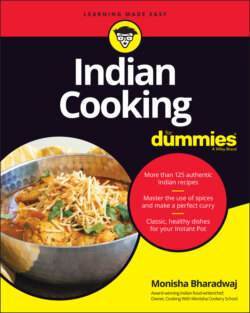Читать книгу Indian Cooking For Dummies - Monisha Bharadwaj - Страница 51
Karahi
ОглавлениеYou may have seen small decorative versions of karahis — they’re often used as serving dishes in Indian restaurants. You can’t use decorative karahis for cooking. Instead, what you’re looking for are the larger cooking karahis (see Figure 3-2), which are somewhat similar to a wok in shape but are made of a thicker material. Some karahis have two small ear-shaped handles; others have none. Karahis are sold with a pair of tongs because the handles are made of metal and get as hot as the karahi itself! You can also buy a matching lid with your karahi — the lid has a lip that allows it to sit snug over the top, sealing in the steam.
You can’t use a wok instead of a karahi — your curry might stick to the bottom. Although woks have a similar shape, a wok is much thinner because it’s used for stir-frying on a high heat. A karahi is used for longer cooking processes and is much thicker.
I use a 14-inch (diameter) karahi for a curry for four people, but I also have a huge set of karahis in varying sizes all stacked up in my kitchen drawer. I also use them for frying, because the convex shape allows the oil to pool at the bottom, which means you can use much less oil than you would need in a frying pan. You can cook curries, dals, and dry vegetable dishes in karahis. And best of all, they’re dishwasher safe!
Photograph by Wendy Jo Peterson and Geri Goodale
FIGURE 3-2: Karahis.
